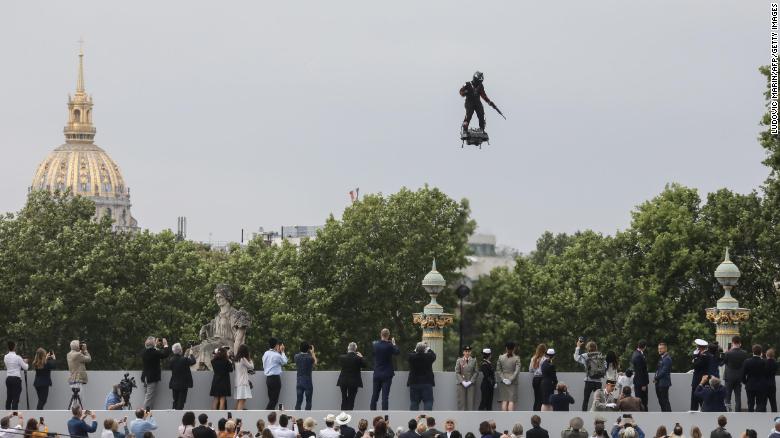Turning Science Fiction Into Factual Reality
 |
"The government [of the United States, following 9/11] considered that it had been the victim of a lack of imagination."On Bastille Day, France showcased the Nerod F5, microwave jammer shaped like a rifle that blocks a drone pilot's control signals. During the Bastille Day military parade that took place on July 14 in Paris, inventor, professional pilot, former jetskiing champion, military reservist Franky Zapata demonstrated his futuristic jet-propelled "fly-board" which enabled him to soar into the air on the hoverboard-type device well over the assembled dignitaries and spectators crowded below.
"It is certainly not the Red Team that will decide France's military strategy and still less its defence policy."
"Its role will be to help the Defence Innovation Agency think about future technologies and their impact on strategies."
Bruno Tertrais, deputy director, Foundation for Strategic Research, France
"[The Barakuda, a] mule [robot could soon be deployed to provide logistical support and ferry supplies to soldiers on the battlefield]."
"Aircraft capable of interacting with drones and software capable of instantly analyzing thousands of satellite images [represent other types of projects]."
French Minister of Defence Florence Parly
A "Red Team" of science fiction writers is being assembled by the French military for the purpose of giving inspiration to military strategists in anticipation of ongoing and future threats to national security. France's recently established Defence Innovation Agency prepared a report to the effect that four or five visionaries are in the process of being brought on board to use their imaginations to identify "scenarios of disruption" that could conceivably not be identified by military planning professionals.

From the fertile imagination of theoretical inventive geniuses like Leonardo da Vinci whose own work on military inventions such as an armoured tank which generations later became reality, to works of science fiction imagining space travel, now also being pioneered, and on forward to seeing once-imagined, and now-realized functions of transportation by unmanned vehicles like drones, those in the population whose minds work overtime to imagine scenarios that closed minds could not possibly think of, are being sought as advisers.
Creative thinking does not come readily to everyone. Deputy director of France's Foundation for Strategic Research, Bruno Tertrais speaks of the role of his team to think in ways more related to that of the mind of a science fiction writer, and to achieve that end, the enrolment of actual science fiction writers to inspire the duller minds of ordinary military personnel is envisioned as a necessary first step in out-thinking and out-imagining possible enemies before disasters occur.
 |
Science fiction writers, he pointed out, were invited by U.S. authorities to participate in defence brainstorming sessions in the wake of the September 11 attacks. France envisions the efficacy of mind-bending similar approaches; to attempt to anticipate how terrorist groups or hostile states could make use of advanced technologies to victimize other states. The 45-year-old Mr. Zapata is an inspiration himself, planning to mark the 110th anniversary of the first aircraft crossing of the English Channel with his flyboard.
His invention is capable of flight for just over ten minutes, achieving a top speed of roughly 115 mph. The 21-mile crossing would challenge the limitations of the flyboard's current capacities. So perhaps it's back to the drawing board for Mr. Zapata, but the intention acts as a spur for further development. And this is precisely the cerebral functioning that inspires the French government to emulate in a mission of preventive self defence.

Labels: France, Military Applications, Science Fiction

<< Home